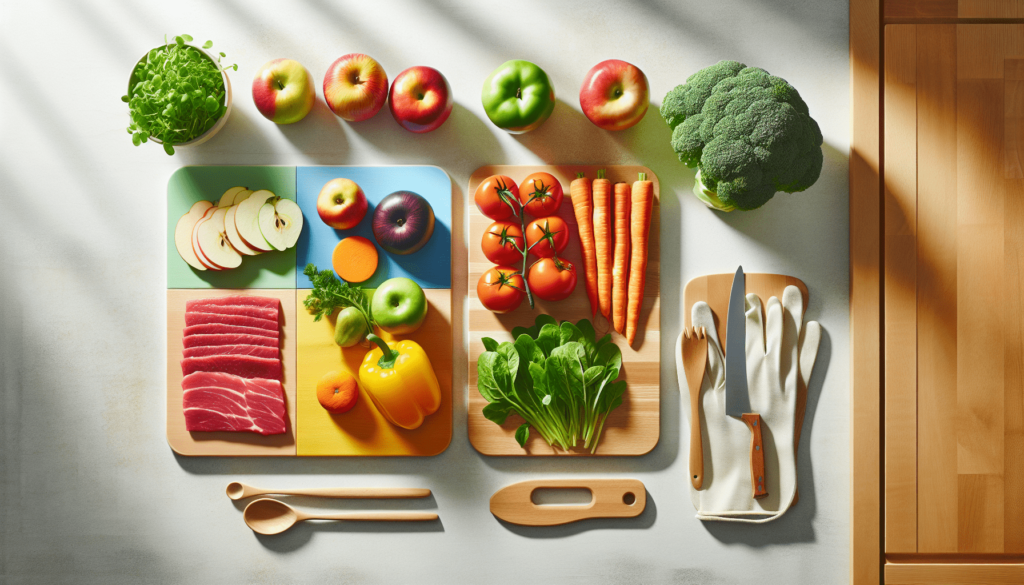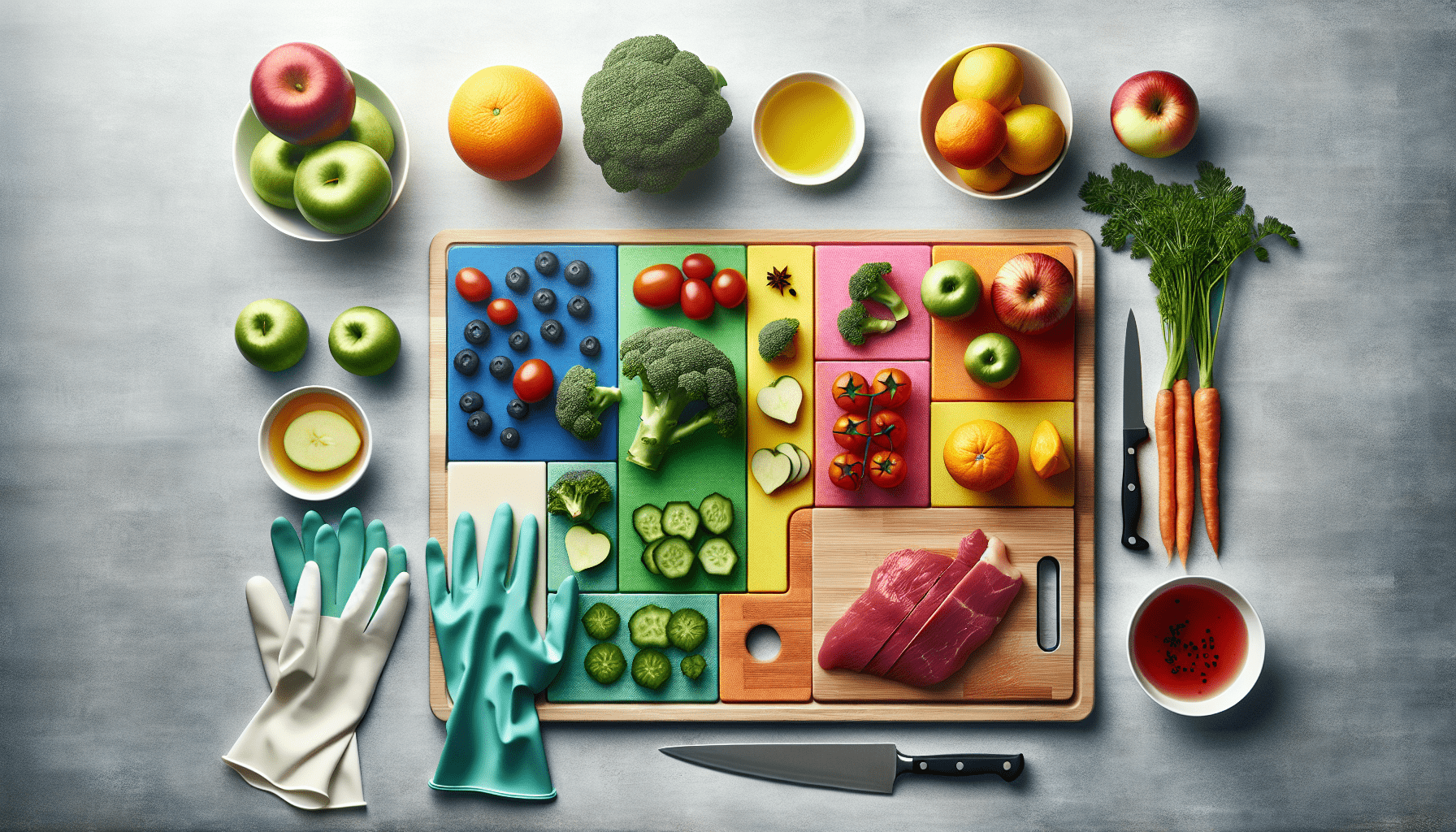Keeping your kitchen safe and hygienic is key to ensuring the health and well-being of you and your loved ones. In “Top Ways To Handle Cross-Contamination In The Kitchen,” you’ll find practical tips and strategies to prevent harmful bacteria from spreading and contaminating food. From proper handwashing techniques to the importance of segregating raw and cooked ingredients, this guide will inform you about simple yet effective practices to maintain a clean cooking environment. By following these tips, you can confidently enjoy your culinary adventures, knowing you’re taking the necessary steps to protect everyone at the table. Have you ever wondered how to keep your kitchen free from the dangers of cross-contamination? It’s one of those things that you might not think about often but can have a significant impact on your health and the health of those you cook for. Taking some simple steps can make your kitchen a much safer place.

What is Cross-Contamination?
Cross-contamination is the process by which bacteria or other microorganisms are unintentionally transferred from one substance or object to another, with harmful effects. It typically happens in kitchens when bacteria from raw food items like meat, poultry, or seafood spread to ready-to-eat foods, surfaces, and utensils. Understanding cross-contamination is the first step to effectively handling it.
Types of Cross-Contamination
To better manage and prevent cross-contamination, knowing its types can be very helpful. Here are the primary types:
-
Direct Cross-Contamination: Happens when raw food directly touches other foods.
-
Indirect Cross-Contamination: Occurs when bacteria are transferred from a surface to food via hands, utensils, or equipment.
Following are practical ways you can actively address these potential risks in your kitchen.
Importance of Proper Kitchen Hygiene
Maintaining a hygienic kitchen is crucial to avoid illnesses caused due to cross-contamination. The better your hygiene, the lower the chances of harmful bacteria affecting your cooking.
Regular Cleaning
Cleaning your kitchen regularly is fundamental. This includes countertops, cutting boards, and utensils. Cleaning isn’t just about washing but also about disinfection to kill any lingering bacteria.
-
Daily Cleaning: Wipe down surfaces and clean utensils immediately after use.
-
Deep Cleaning: Every week, do a thorough clean-up of your kitchen appliances and surfaces with disinfectant.
Handwashing
Your hands can be one of the major carriers of bacteria. Proper handwashing reduces the likelihood of transferring contaminants to food or kitchen surfaces.
-
When to Wash: Always wash your hands before and after handling food, especially raw meat.
-
How to Wash: Use warm water and soap, scrubbing for at least 20 seconds.
Using Separate Cutting Boards
Using separate cutting boards for different types of food will dramatically reduce the risk of cross-contamination.
Color-Coded Boards
A practical approach is to use color-coded cutting boards. Here’s a simple guideline:
| Color | Food Type |
|---|---|
| Red | Raw Meat |
| Blue | Raw Fish |
| Green | Fruits and Vegetables |
| Yellow | Cooked Meats |
By using different boards for different food types, you can make your kitchen significantly safer.
Proper Maintenance
-
Sanitizing: After every use, clean your cutting boards with hot, soapy water and disinfect them.
-
Inspecting for Damage: Replace cutting boards when they show signs of wear and tear, as cracks can harbor bacteria.
Safe Food Storage
Storing food properly can make a big difference in preventing cross-contamination.
Fridge Storage
-
Raw Food Placement: Always store raw meat, poultry, and seafood on the lowest shelves of the fridge to prevent their juices from dripping onto other foods.
-
Seal Containers: Use airtight containers to store your food to keep bacteria from spreading.
Labeling
Labeling stored food with dates can help you keep track of what needs to be used or discarded, reducing the risk of consuming expired items.

Proper Cooking Temperatures
Cooking food to the right temperature can kill most harmful bacteria.
Internal Temperatures
Use a food thermometer to ensure your foods are cooked to safe temperatures:
| Food Type | Safe Internal Temperature |
|---|---|
| Poultry | 165°F (74°C) |
| Ground Meats | 160°F (71°C) |
| Beef, Pork, Lamb | 145°F (63°C) |
| Fish and Shellfish | 145°F (63°C) |
Resting Time
After cooking, some foods require a resting period to ensure the heat kills all bacteria. For example, steaks and roasts should rest for at least three minutes after removing them from the heat source.
Avoiding Cross-Contamination During Food Preparation
During food prep, it’s easy to spread bacteria if you’re not cautious. Here are ways to prevent it:
Use of Utensils
-
Separate Utensils: Use separate knives and utensils for raw and cooked foods.
-
Cleaning Utensils: Clean your knives and cutting boards immediately after working with raw foods.
Marinades and Sauces
- Reusable Marinades: Never reuse marinades or sauces that have been in contact with raw meat, poultry, or seafood unless you bring them to a boil first.
Managing Leftovers Safely
Leftovers can become breeding grounds for bacteria if not handled properly.
Cooling Leftovers
-
Rapid Cooling: Transfer leftovers into small, shallow containers to cool them quickly before refrigerating.
-
Time Limits: Refrigerate or freeze leftovers within two hours of cooking.
Reheating
Reheat your leftovers to at least 165°F (74°C) to ensure any potential bacteria are killed.
Being Cautious with Allergens
Cross-contact with allergens can be as dangerous as cross-contamination with bacteria.
Segregation
-
Separate Areas: Use separate areas and utensils for preparing allergy-friendly foods.
-
Clear Labeling: Clearly label containers with potential allergens to avoid accidental mixing.
Attention to Detail
Always clean surfaces and utensils thoroughly after preparing foods with common allergens to prevent accidental ingestion.
Educating Family and Friends
Everyone who uses your kitchen should be aware of the importance of avoiding cross-contamination.
Sharing Knowledge
-
Family Training: Teach your family members about hygienic practices and the importance of using separate utensils.
-
Guest Awareness: Inform guests about your kitchen rules if they are helping you prepare food.
Reinforcement
- Regular Reminders: Regularly remind everyone to follow the rules, especially after shopping trips or grocery deliveries.
Avoiding Habitual Mistakes
Sometimes, cross-contamination happens out of habit. Being mindful and making small changes can help a lot.
Common Mistakes
Here are a few common mistakes to avoid:
-
Using the Same Towel: Don’t use the same towel to dry your hands and wipe down surfaces.
-
Double-Dipping: Avoid double-dipping utensils or tasting spoons into your dishes.
Developing Good Habits
-
Consistent Practices: Make cleanliness and separation practices a consistent part of your cooking routine.
-
Mindfulness: Stay conscious of what you touch, ensuring that your hands, utensils, and surfaces are always clean.
Reviewing and Updating Kitchen Practices
Your kitchen hygiene practices should evolve over time for effectiveness.
Regular Audits
Conduct regular audits of your kitchen practices. Are there areas where you can improve? Would additional tools or gadgets help?
Feedback Loop
Encourage feedback from family or housemates. They might have noticed areas you overlooked and can help keep your kitchen safer.
Staying Informed
Keep yourself updated on the latest guidelines and tips for preventing cross-contamination. Food safety standards evolve, and staying informed helps you adapt more effectively.
Conclusion
Preventing cross-contamination in the kitchen is straightforward when you’re aware and take appropriate measures. By maintaining proper hygiene, using separate utensils and cutting boards, storing food correctly, and cooking food to safe temperatures, you can significantly reduce the risk of foodborne illnesses. Remember, it’s about creating habits and routines that make your kitchen a safe space for everyone who eats from it. Take these steps seriously, and you’ll turn your kitchen into a fortress of cleanliness and safety.
